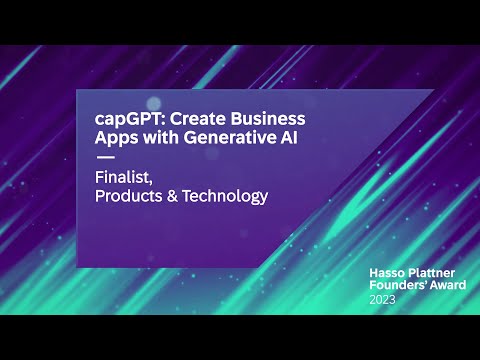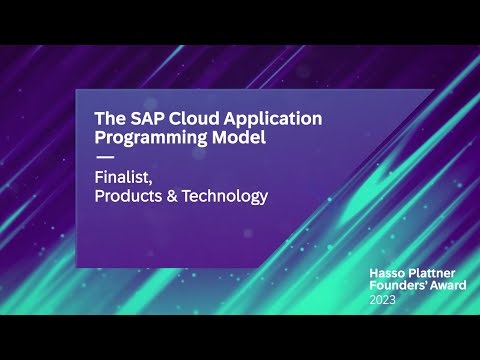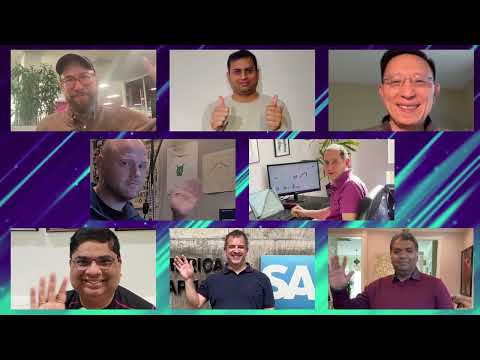Nine teams across three categories are vying for this year’s Hasso Plattner Founders’ Award. Each category reflects a different type of breakthrough thinking, considering the various ways in which innovation drives SAP’s success.
Meet the 2023 finalists in the Products and Technology category.
capGPT – Create Business Apps with Generative AI
A mixture of fright and thrill rippled through the tech community when AI chatbot ChatGPT entered the stage in December 2022, setting new standards for generative AI. In Walldorf, Germany, SAP software architect David Kunz immediately wondered whether ChatGPT’s large language model could be applied not only to answering questions about everything and anything, but also to writing code for apps.
“To build SAP extensions running on SAP Business Technology Platform (SAP BTP) – even if it’s just to build a prototype – requires a lot of deep knowledge, including learning programming languages,” Kunz explains. “Even for experienced developers, it can take up to a week to complete a prototype.”
Still, his suggestion of having a large language model like ChatGPT generate apps was met with skepticism.
“‘That’s too ambitious,’ was what everyone thought at the time,” Kunz remembers. “To be honest, this feedback was justified. I was not at all sure it was going to work. But I knew the general direction steps had to be taken in.”
Breakthrough on a Friday night
The idea never left him. One Friday evening in spring 2023, Kunz sat down and started to work through the steps he had outlined in his proposal earlier.
At half past midnight, he sent out a video of the successfully completed process to his colleagues. From there capGPT made its way – in a refined form able to generate not only backend applications, but also user interfaces – to CTO and Executive Board Member of SAP SE Juergen Mueller’s SAP Sapphire keynote.
“The support I received was amazing,” says Kunz, who now divides his time between capGPT and his role as an architect with the CAP team. capGPT has been adopted by many SAP developers for their own generative AI projects.
capGPT allows users to write down in natural language what their app prototype should be able to do, receive all the code – which previously had to be written by hand – in as little as 30 seconds, and access the prototype to test it. This not only saves experienced developers an amazing amount of time, but also enables non-developers to create prototypes of the apps they need.
“From experienced developers spending a week to build a prototype to anyone spending 30 seconds – that’s what capGPT does,” Kunz says. “And by just looking at the code, it’s impossible to tell whether it was written by a human or by the machine.”
Finalist Fast Facts
- Submission Title: capGPT – Create Business Apps with Generative AI
- Team: David Kunz
- Number of Employees: 1
- Achievement: Lighthouse generative AI project, massively increased prototyping speed in business application development
- Impact: Core pillar of SAP Build Code, enabled “Feedback to Code,” “abapGPT,” and other projects
CAP – The SAP Cloud Application Programming Model
When SAP Cloud Platform became available, there was a hot debate going in the SAP developer community on how to best build applications on top of it.
Developers could choose from a huge number of technologies, but there was a general lack of guidance. Also, integration with the platform services required a relatively high effort.
Ole Lilienthal, senior development manager for SAP Cloud Application Programming, says: “We realized that, regardless of the business problem their app was supposed to solve, each developer and every development team was facing similar efforts when integrating with all the existing cloud services the platform offered.”
With the SAP Cloud Application Programming (CAP) Model, Lilienthal and his team hit the bull’s-eye.
Started in 2018, the project was aiming for a programming model that could guide developers when building apps on SAP Cloud Platform, which has evolved into what is now SAP Business Technology Platform.
Safeguarding Customers’ Investments and Increasing Speed and Productivity
“With CAP as a development framework, we wanted to automatically solve about 80% of the problems every backend developer is facing,” Lilienthal explains.
Typically, those problems include multi-tenancy, expandability, or business features such as localization and translatability. But thanks to CAP’s domain-driven approach, it is no longer necessary to always change the coding in each of those cases. As for special use cases that CAP doesn’t cover, the coding can be easily added to build in this functionality.
“This has been a huge improvement to the productivity and speed of developers and also to the alignments between development teams,” Lilienthal says.
To help safeguard customers’ investments, CAP offers the possibility to interchange components, such as runtime or the database, without changing the actual implementation.
As they saw the advantages CAP offers, internal SAP developers started to migrate from their existing stacks. External feedback has been particularly good, leading over time to the forming of a wide external community around CAP.
The team – located mostly in Walldorf and Bangalore, India – took a couple of already existing innovations and created something new, and then brought it to the next level. In a world of rapidly changing cloud technologies, the SAP Cloud Application Programming Model can accelerate development and safeguard customers’ investments.
Finalist Fast Facts
- Submission Title: CAP – The SAP Cloud Application Programming Model
- Team: Christian Georgi, Dr. Adrian Goerler, Sebastian Schmidt, Daniel Hutzel, Johannes Vogel, Dr. Steffen Weinstock, Dr. Michael Spahn, Matthias Braun, Ole Lilienthal, Michael Hellenschmidt
- Number of Employees: 50
- Achievement: CAP, as a centerpiece of Golden Path and SAP Build Code, became an integral part of the consumption experience of SAP BTP.
- Impact: Thousands of internal and external developers use CAP to help build business applications on SAP BTP, driving higher developer productivity and easier SAP BTP service adoption.
SAP Ariba Category Management
Traditionally, procurement challenges involve minimizing costs, sustaining quality, and ensuring on-time delivery. But in an increasingly volatile world, procurement goals have evolved to be more complex, as they now involve running in a sustainable and socially responsible manner.
“Category management is one of the leading practices that help procurement drive efficiencies,” says Lincy T. Elizabeth, product manager for SAP Ariba Category Management, SAP Labs Bangalore. “It allows organizations to categorize spend, focus on consolidation, and enhance efficiencies with a holistic view of all the requirements in terms of goods and services that are needed across multiple departments, regions, and geographical locations.”
“However, what has always kept category management from reaching its full potential is that it is a manual and data-intensive exercise that results in isolated offline strategy documents disconnected from execution systems,” Elizabeth says. “It seldom translates to successful execution and strategy compliance.”
This is where the SAP Ariba Category Management solution comes in: it can digitize this entire process.
Positioning Procurement as an Enabler of Digital Transformation
Data analysis is key in this process, so instead of having to drill down to find information, SAP Ariba Category Management can serve up data intelligently. It features a guided process leveraging analytics, generative AI, and modular tools – helping to make an otherwise complex, time-consuming process into a streamlined one.
Customers have acknowledged the need for digitized category management and the value that this solution brings them.
“This is very evident in the solution’s inclusion in renewal discussions and the subsequent wins,” Elizabeth says. “In fact, most customers we speak to see category management as one of the top drivers for digital transformation in their procurement organization.”
SAP Ariba Category Management can empower procurement to be a catalyst in an organization’s journey towards becoming an agile, intelligent, and sustainable enterprise.
“We saw the untapped opportunities in the manual process of category management and sprang into action,” Elizabeth explains. “Our team underscores SAP’s innovative spirit as we brought this innovation to our customers in just under two years. We’re immensely proud to see the value it can provide to customers in the longer run.”
Finalist Fast Facts
- Submission Title: SAP Ariba Category Management
- Team: Salvatore Lombardo, Vikram Pathak, Hong Xu, Roberto Valdovinos, Michael Waugh, Lincy Thankachan Elizabeth, Jason Kirst, Vinay Maathur, Jose Roberto Irion Kuplich, Vinod Kumar Singh Bondili
- Number of Employees: 10
- Achievement: Turned market vacuum into thriving SAP opportunity, released product in August 2023, first set of signed customers have started implementing the solution, strong sales pipeline, featured at d-com, AI Enablement Day, and DSAG events
- Impact: Digitizes the strategic foundation of source-to-pay processes, drives SAP Business AI strategy with contextual generative AI integrations, integrates well with other SAP solutions and partner offerings thus fostering the SAP ecosystem
Top photo courtesy of SAP employee Hitesh Deka






